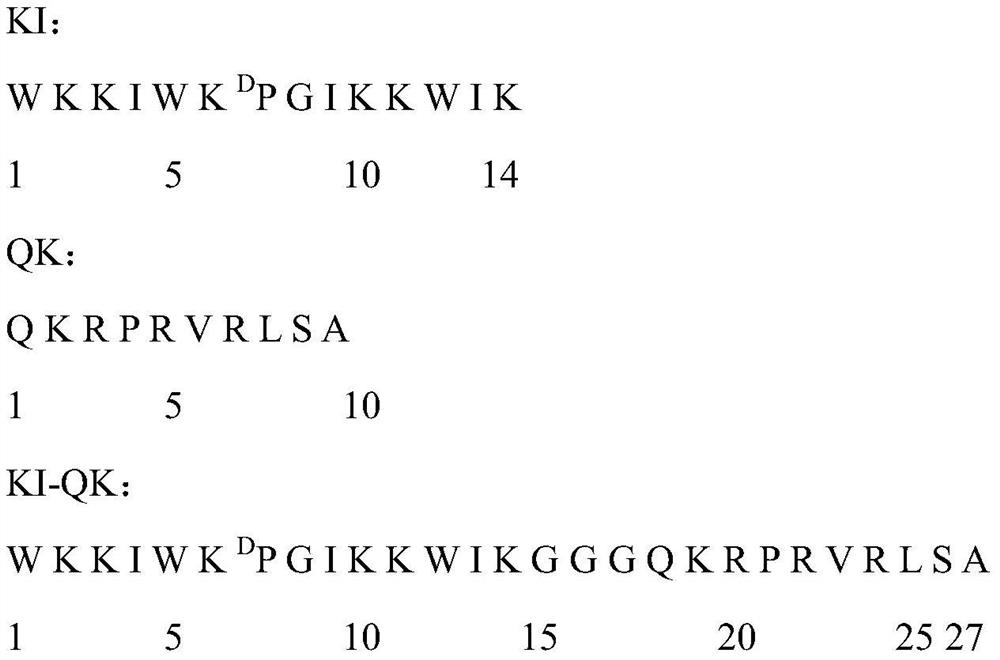A kind of Escherichia coli targeting antimicrobial peptide ki-qk and its preparation method and application
A KI-QK, Escherichia coli technology, applied in the biological field, achieves high application value, simple experimental technology, and strong targeting effect
- Summary
- Abstract
- Description
- Claims
- Application Information
AI Technical Summary
Problems solved by technology
Method used
Image
Examples
Embodiment 1
[0015] Design of Antimicrobial Peptides
[0016] In this example, we used a known peptide QK (CN 103590116 A) with strong affinity for Escherichia coli screened by phage display technology, and connected it with an α-helical peptide KI with antibacterial activity of Escherichia coli , so as to design a new peptide KI-QK with strong targeting antibacterial activity against Escherichia coli. The QK antimicrobial peptide was connected to the C-terminus of KI of the original peptide, and then three glycines were added between KI and QK as a linker, and the above antimicrobial peptide was synthesized by solid-phase synthesis using a peptide synthesizer. The amino acid sequence of the antimicrobial peptide is:
[0017]
[0018] The sequences of the antimicrobial peptides are shown in Table 1.
[0019] Amino acid sequence of table 1 peptide
[0020]
[0021]
[0022] The charge number of KI-QK is +10, and the hydrophobic value is 0.244. The two peptide chains are connect...
Embodiment 2
[0024] Synthesis of KI-QK by Solid Phase Chemical Synthesis
[0025] 1. The preparation of antimicrobial peptides is carried out one by one from the C-terminal to the N-terminal, and is completed by a peptide synthesizer. First, Fmoc-X (X is the first amino acid at the C-terminal of each antimicrobial peptide) is inserted into Wang resin, and then the Fmoc group is removed to obtain X-Wang resin; then Fmoc-Y-Trt-OH (9 -Fmoxy-trimethyl-Y, Y is the second amino acid at the C-terminus of each antimicrobial peptide); according to this procedure, it is synthesized from the C-terminus to the N-terminus until the synthesis is completed, and the side of the Fmoc group is removed chain protection resin;
[0026] 2. Add a cleavage reagent to the peptide resin obtained above, react for 2 hours at 20°C in the dark, filter; wash the precipitate with TFA (trifluoroacetic acid), mix the washing liquid with the above filtrate, concentrate with a rotary evaporator, and then add 10 times Abou...
Embodiment 3
[0029] Embodiment 3: the mensuration of antimicrobial peptide biological activity
[0030] 1. Determination of antibacterial activity: The minimum inhibitory concentration of several antibacterial peptides was determined by the micro broth dilution method. Using 0.01% acetic acid (containing 0.2% BSA) as the diluent, a series of gradient antimicrobial peptide solutions were sequentially prepared using the doubling dilution method. Take 100 μL of the above solution and place it in a 96-well cell culture plate, then add an equal volume of the bacteria solution to be tested (~10 6 individual / mL) in each well. Positive controls (containing bacterial fluid but not antimicrobial peptides) and negative controls (neither bacterial fluid nor peptides) were set up. Cultivate at a constant temperature of 37°C for 24-25h, measure the light absorption value at 492nm (OD492nm) with a microplate reader, and determine the minimum inhibitory concentration. The test results are shown in Tabl...
PUM
 Login to View More
Login to View More Abstract
Description
Claims
Application Information
 Login to View More
Login to View More - R&D
- Intellectual Property
- Life Sciences
- Materials
- Tech Scout
- Unparalleled Data Quality
- Higher Quality Content
- 60% Fewer Hallucinations
Browse by: Latest US Patents, China's latest patents, Technical Efficacy Thesaurus, Application Domain, Technology Topic, Popular Technical Reports.
© 2025 PatSnap. All rights reserved.Legal|Privacy policy|Modern Slavery Act Transparency Statement|Sitemap|About US| Contact US: help@patsnap.com



